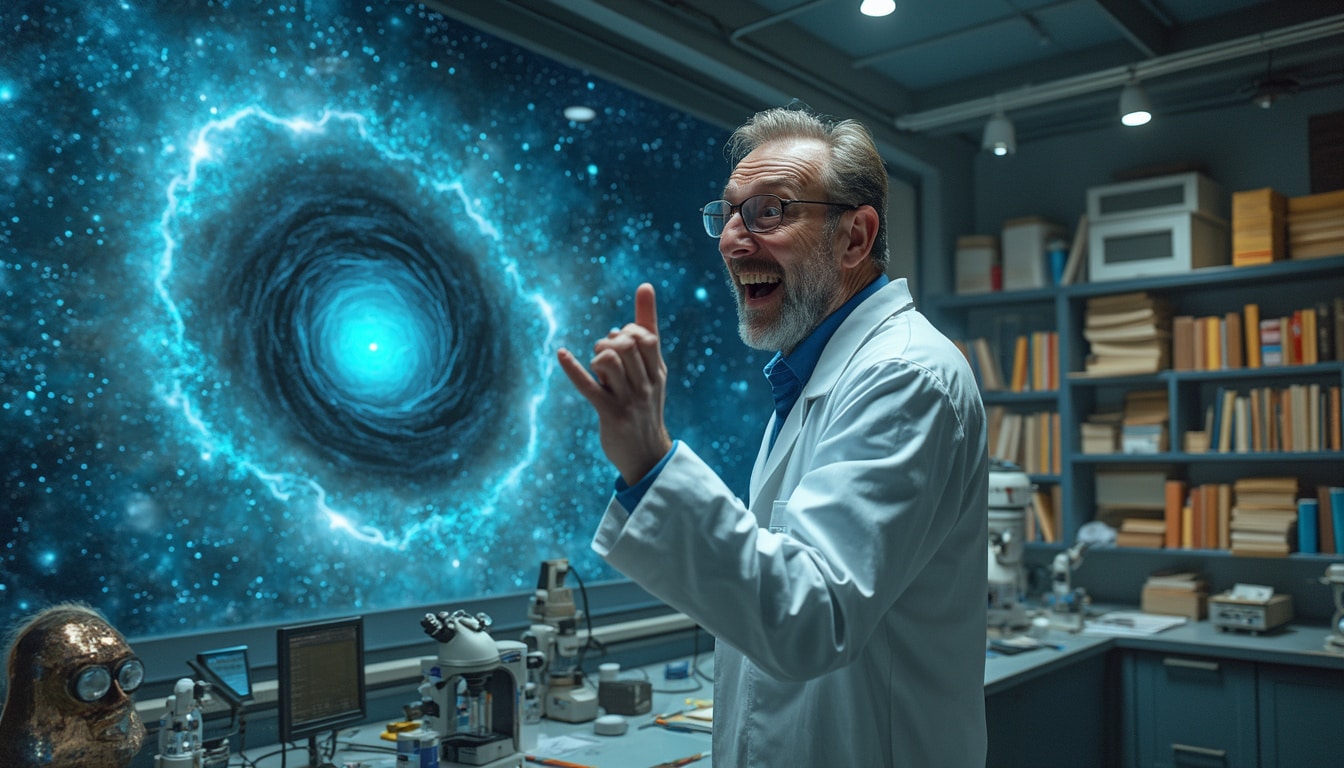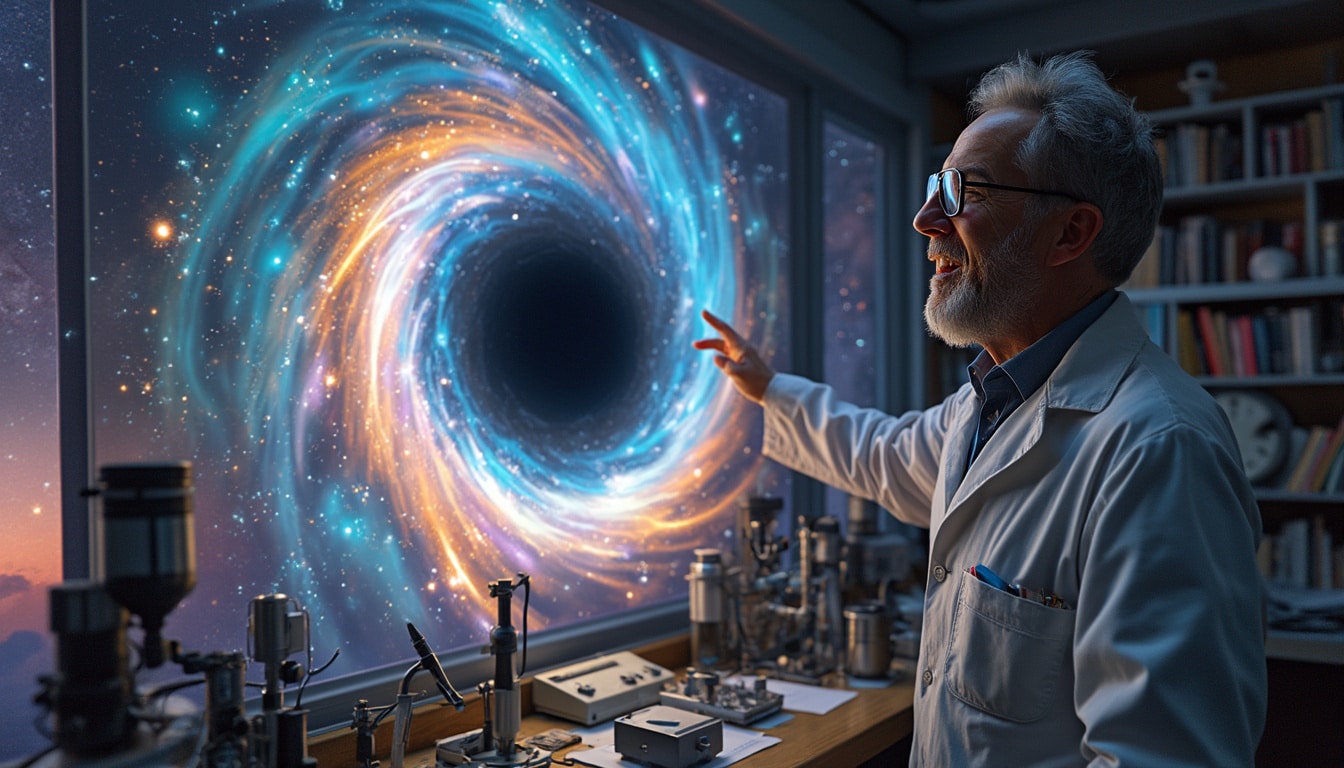« `html
What if black holes aren’t just cosmic vacuum cleaners? Imagine our entire universe tucked away inside one. Sounds like sci-fi, right?
Recent studies suggest that primordial black holes might be hiding in the most unexpected places, possibly even within our own planets. Scientists have discovered evidence indicating that these tiny cosmic enigmas could have left behind hollow planetoids and microscopic tunnels. The discovery of an extraordinarily massive black hole has ignited debates about the true nature of our universe. Could it be that our entire cosmos is actually trapped inside a black hole? Theories like Schwarzschild cosmology are gaining traction, proposing that our observable universe might reside within the interior of a black hole in a larger parent universe. Observations from the James Webb Space Telescope are providing new insights, revealing black holes in the early universe that challenge existing models. These groundbreaking ideas are pushing the boundaries of cosmology, leaving scientists both excited and bewildered.

Table of contents
ToggleHas a scientist really found evidence our universe is trapped in a black hole?
Imagine waking up one day to discover that every star, every galaxy, and indeed, every atom you know, is nestled within the confines of a black hole. Sounds like the plot of a sci-fi blockbuster, right? Well, a bold new hypothesis suggests just that might be our reality. A renowned scientist has presented compelling arguments and preliminary evidence supporting the idea that our entire universe is actually trapped inside a colossal black hole. This theory, often referred to as « Schwarzschild cosmology, » posits that what we perceive as our universe could be the interior of a black hole existing within a larger parent universe.
The evidence presented revolves around unusual patterns observed in the rotation of galaxies and the behavior of dark matter. These anomalies hint at the possibility that the universe’s expansion could be the result of a rapid recoil from a massive bounce event inside a black hole, leading to what we know as the Big Bang. If this theory holds water, it would revolutionize our understanding of cosmology, offering a new lens through which to view everything from the formation of galaxies to the very fabric of space-time itself.
However, it’s essential to approach such groundbreaking claims with a healthy dose of skepticism. The scientific community is eagerly awaiting further evidence and peer-reviewed studies to substantiate these claims. Until then, the idea that we’re living inside a black hole remains an intriguing yet unconfirmed theory that continues to spark lively debates among physicists and cosmologists alike.
What are primordial black holes and could they be hiding in our planet?
Primordial black holes are a fascinating concept in astrophysics. Unlike their stellar counterparts, which form from the gravitational collapse of massive stars, primordial black holes are believed to have originated in the very early universe, moments after the Big Bang. These tiny black holes could range from the size of a grain of sand to much larger, depending on the density fluctuations present in the early cosmos.
Recent studies suggest that these primordial black holes might still be lurking in places we might least expect, including within our own planets. Imagine microscopic tunnels or hollow planetoids left behind by these early cosmic phenomena. While the idea sounds like something out of a mystery novel, scientists are investigating whether these remnants could explain some of the unexplained anomalies we observe in planetary formations and behaviors.
For instance, the James Webb Space Telescope has provided unprecedented insights into the early universe, revealing black holes that appear « too big, too fast » to have formed through traditional stellar collapse. Such discoveries lend credence to the primordial black hole theory, suggesting that these ancient cosmic monsters might have played a significant role in shaping the universe as we know it. If proven true, this could not only solve some long-standing puzzles in astrophysics but also bring us a step closer to understanding the true nature of our cosmic surroundings.
How do recent discoveries challenge Stephen Hawking’s black hole theories?
Stephen Hawking revolutionized our understanding of black holes with his groundbreaking theories, particularly the concept of Hawking radiation suggesting that black holes emit radiation and can eventually evaporate over time. However, recent discoveries are stirring the pot, presenting data that might challenge or even support certain aspects of Hawking’s theories in unexpected ways.
One such discovery is the observation of a stupendously powerful neutrino that has left scientists scratching their heads. New research indicates that this neutrino could be evidence aligning with Hawking’s predictions about the nature of black holes and their interactions with surrounding matter. Additionally, the detection of « impossible » black holes by the James Webb Space Telescope — black holes that seemingly grew too large too quickly — hints at phenomena that Hawking’s original theories might not fully account for.
These findings suggest that the mechanisms governing black hole growth and behavior are more complex than previously thought. Some scientists argue that rapid recoil events following black hole mergers could provide the energy needed for our expanding universe, tying back to Hawking’s ideas in a more intricate cosmic dance. As researchers continue to peel back the layers of black hole dynamics, we may find that Hawking’s legacy remains a cornerstone of astrophysical theory, even as new data refines and expands our understanding.
What have the James Webb Space Telescope revealed about black holes?
The James Webb Space Telescope (JWST) has been nothing short of a revelation for astronomers and astrophysicists worldwide. Its advanced capabilities have allowed us to peer deeper into the cosmos than ever before, uncovering astonishing details about the early universe and the black holes that inhabit it. One of the most notable findings is the identification of monster black holes that appeared much larger and younger than existing theories would predict.
These colossal black holes, detected in the distant reaches of the universe, challenge our understanding of how black holes grow and evolve. The speed at which they amassed mass suggests that conventional models, which rely on stellar collapse and gradual accretion, might be incomplete or missing crucial elements. This discrepancy has led scientists to explore alternative explanations, including the role of dark matter and the potential influence of primordial black holes in their rapid growth.
Moreover, JWST’s observations have shed light on the peculiar behavior of black holes in the early universe, such as their high rate of energy output and the formation of microscopic tunnels in space-time. These findings not only provide new insights into the life cycle of black holes but also open the door to testing and refining our existing theoretical frameworks. As JWST continues its mission, we can expect a steady stream of data that will further illuminate the enigmatic nature of these cosmic giants.
Could our universe have existed inside a supermassive black hole?
The notion that our entire universe might be nested within a supermassive black hole is both mind-bending and tantalizing. This theory suggests that what we perceive as the vast expanse of the cosmos is actually contained within the event horizon of a black hole residing in a parent universe. If true, it would mean that our universe’s existence is intrinsically linked to the mechanics of black holes on a grand scale.
One scientist advocating this theory points to the rapid expansion of the universe as a potential consequence of a massive bounce event within a black hole. According to this line of thought, the Big Bang could be interpreted as a result of this rebound, propelling the universe into its current state of expansion. This idea aligns with Schwarzschild cosmology, a Russian doll-like theory where each universe exists within a black hole in a larger cosmos.
Supporting this hypothesis are observations related to the rotation patterns of galaxies and the distribution of dark matter. These cosmic fingerprints may indicate that the fundamental forces and forces governing our universe operate under the influence of the black hole’s immense gravitational pull. While this theory is still in its infancy and requires extensive validation, it provides a provocative framework for rethinking the origins and structure of everything we know.
What does black hole cosmology say about the origin of our universe?
Black hole cosmology offers a radical perspective on the origins of the universe, positing that our observable cosmos is merely the interior of a black hole. This idea diverges significantly from the traditional Big Bang theory, suggesting an alternative pathway for the birth and evolution of the universe.
At the heart of this theory is the concept that a black hole’s gravitational pull creates a boundary, effectively containing a new universe within it. The Big Bang, in this context, is not the beginning of creation but a transition point resulting from fluctuations within the parent black hole. This reshapes our understanding of cosmic development, implying that universe creation is a repetitive process occurring within an infinite hierarchy of black holes.
Proponents of black hole cosmology argue that this model can account for certain cosmological anomalies, such as the uniformity of the cosmic microwave background radiation and the distribution of dark matter. By framing the universe within a black hole, it provides a natural mechanism for explaining how space-time can expand and evolve without violating the fundamental principles of relativity and quantum mechanics. While still speculative, black hole cosmology remains a compelling avenue of research that challenges and enriches our comprehension of the universe’s ultimate origins.
How might black holes influence future human understanding and exploration?
Black holes, with their enigmatic properties and extreme conditions, have long been subjects of fascination and study in astrophysics. As our knowledge deepens, their influence extends beyond the realms of scientific theory, potentially shaping the future of human understanding and exploration of the cosmos.
One of the most profound implications of black hole research is the possibility of interdimensional travel or communication. If our universe is indeed contained within a black hole, as some theories suggest, understanding the mechanisms at play could unlock unprecedented technologies for traversing or interacting with other cosmic realms. This could revolutionize space travel, making what was once considered purely theoretical now a tangible possibility.
Furthermore, advancements in black hole detection and analysis, spearheaded by instruments like the James Webb Space Telescope, are likely to provide deeper insights into the fabric of space-time itself. This knowledge could inform the development of new materials, energy sources, and even computational technologies inspired by the properties of black holes. Additionally, the intersection of black hole research with cybersecurity, as highlighted in recent efforts to strengthen defenses against cyber attacks, underscores the broad applicability of black hole studies in diverse fields.
Ultimately, the ongoing exploration of black holes not only pushes the boundaries of our scientific knowledge but also inspires innovations that could have far-reaching impacts on technology, industry, and our broader understanding of existence itself.
What are the potential risks and ethical considerations in black hole research?
Diving into the depths of black hole research comes with its own set of risks and ethical considerations. While the pursuit of knowledge is a noble endeavor, the implications of harnessing or interacting with such powerful cosmic phenomena must be carefully weighed.
One significant risk is the potential for catastrophic accidents if humanity were to attempt to manipulate or travel into black holes without a complete understanding of their properties. The immense gravitational forces and unknown consequences of crossing an event horizon pose existential threats that could result in the loss of the materialized universe we currently reside in.
Moreover, the ethical implications of controlling or influencing black hole dynamics touch upon profound questions about our responsibility as stewards of advanced technology. The ability to manipulate space-time has far-reaching consequences that could affect not just our universe but potentially every universe nested within parent black holes, according to current theories.
These considerations necessitate a framework of ethical guidelines and international cooperation to ensure that black hole research progresses responsibly. Just as with other powerful technologies, the balance between scientific advancement and ethical responsibility is crucial to safeguarding both current and future generations from unintended consequences.
How do government policies impact black hole research and innovation?
The trajectory of black hole research and innovation is significantly influenced by government policies and funding priorities. Effective policy-making can either accelerate scientific breakthroughs or hinder progress due to bureaucratic red tape and funding shortfalls.
For instance, the recent scrutiny of projects like California’s High-Speed Rail Project underscores the challenges large-scale scientific initiatives face in securing necessary resources. Similarly, the cutting of innovation support in budgets, as seen in Thales’ case, can have a detrimental effect on emerging research areas, including those exploring the mysteries of black holes.
Conversely, robust policies that prioritize scientific inquiry and safeguard against cyber threats — as highlighted in government efforts to strengthen defenses against cyber attacks — can provide a stable foundation for secure and uninterrupted research endeavors. Moreover, public awareness and safety concerns, such as beware of malicious QR codes, demonstrate the interconnectedness of technological innovation, public policy, and everyday safety, all of which play a role in shaping the environment in which black hole research thrives.
Additionally, opinion pieces like Exploring the Ineffectiveness of French Innovation Policy highlight the need for adaptable and forward-thinking policies that can keep pace with rapid scientific advancements. By fostering an ecosystem that encourages creativity, collaboration, and sustained funding, governments can ensure that black hole research and other cutting-edge scientific fields continue to advance, unlocking the secrets of the universe for generations to come.
What technological advancements are driving black hole research forward?
Technological advancements are the lifeblood of black hole research, enabling scientists to explore phenomena that were once beyond the realm of human comprehension. From sophisticated telescopes to advanced computational models, the tools at our disposal are continually evolving, pushing the boundaries of what we can observe and understand.
The James Webb Space Telescope stands at the forefront of these technological marvels, providing unprecedented resolution and sensitivity that allow astronomers to detect and study black holes in the early universe with remarkable precision. Its ability to observe in the infrared spectrum opens up new avenues for investigating the intricate details of black hole formation and growth, shedding light on questions that have puzzled scientists for decades.
Moreover, advancements in quantum computing and artificial intelligence are revolutionizing the way we model and simulate black hole dynamics. These powerful computational tools enable researchers to process vast amounts of data and perform complex calculations that were previously impossible, leading to more accurate predictions and deeper insights into the behavior of black holes under extreme conditions.
Additionally, innovations in materials science and engineering are enhancing the durability and functionality of space-based observatories, allowing for longer missions and more detailed observations. As technology continues to advance, the synergy between scientific curiosity and technical capability will undoubtedly propel black hole research into new frontiers, offering glimpses into the very fabric of the cosmos.
How can the public stay informed and involved in black hole discoveries?
Staying informed and involved in the latest black hole discoveries is easier than ever, thanks to the proliferation of online resources, educational platforms, and science communication initiatives. Public interest in black holes has surged, fueled by both scientific breakthroughs and their portrayal in popular media, making it a vibrant field of discussion and exploration.
One effective way to stay updated is by following reputable scientific news outlets and journals that regularly publish articles on recent advancements in astrophysics and cosmology. Engaging with content from sources like NASA and the James Webb Space Telescope can provide accurate and up-to-date information straight from the experts.
Participating in public lectures, webinars, and science fairs is another excellent method to deepen your understanding and connect with the scientific community. Universities and research institutions often host events that are open to the public, offering opportunities to learn from leading scientists and ask questions about the latest research.
Additionally, leveraging social media platforms and online forums can facilitate engagement with experts and enthusiasts alike. Platforms like Twitter, Reddit, and specialized science forums allow individuals to share insights, discuss theories, and stay abreast of ongoing discoveries in real-time.
For those who prefer a more hands-on approach, volunteering with local science museums or astronomy clubs can provide practical experience and foster a deeper appreciation for the mysteries of black holes. By actively seeking out information and participating in community activities, the public can play a meaningful role in the ongoing exploration of one of the universe’s most intriguing phenomena.














